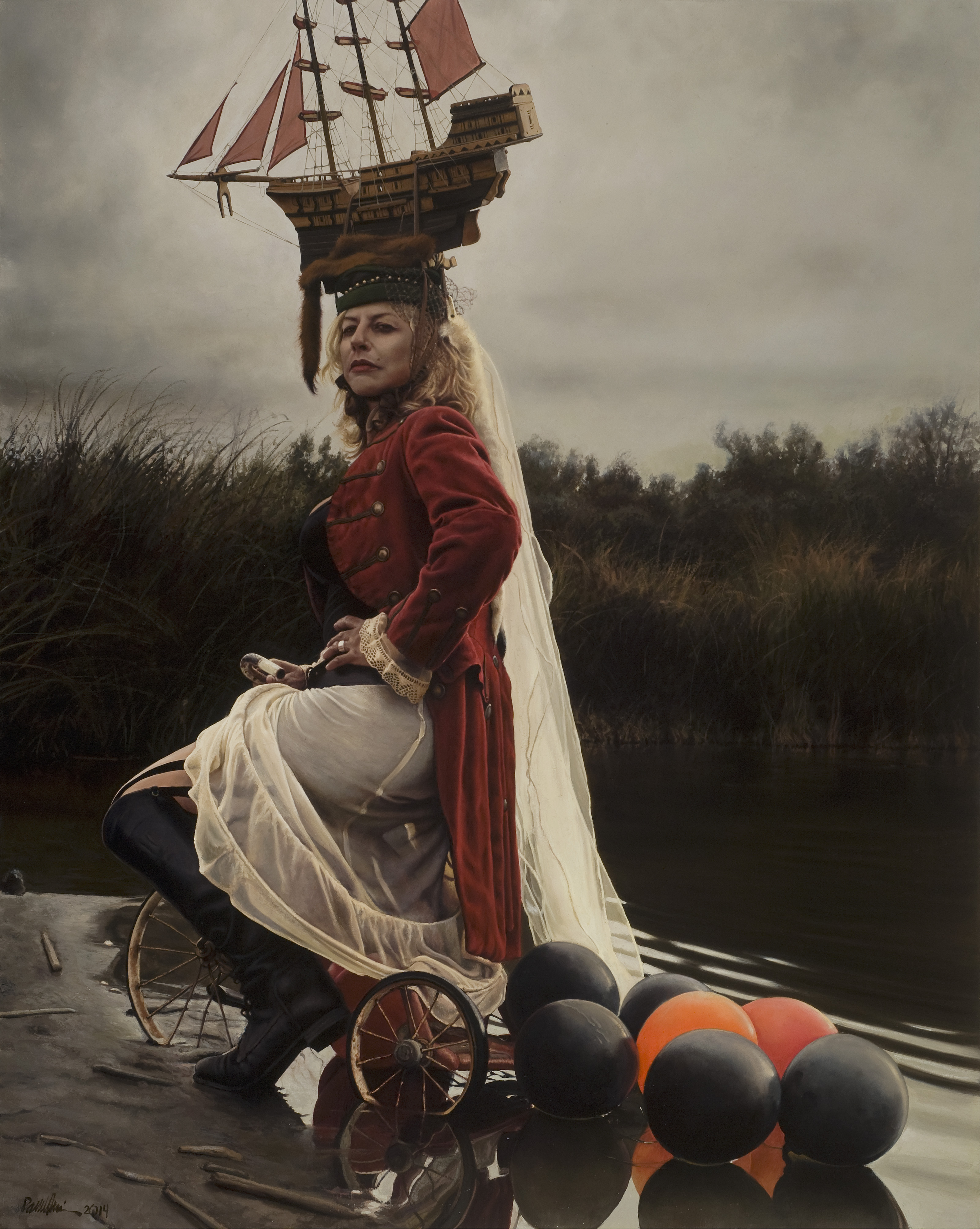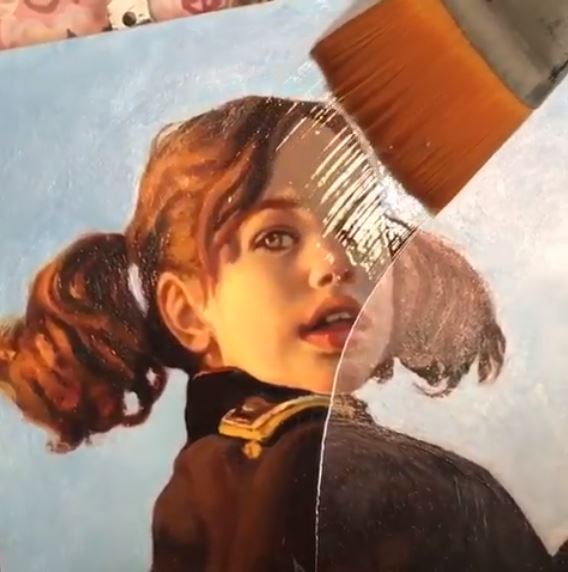On Using Varnish for an Oil Painting > “Varnish is the great barrier,” says Pamela Wilson, “protecting your painting from a lifetime of dust, grime, weather, heat, cold, age, sunlight, ex-boyfriends, and spilled milk. It brings to life every stroke, every glazed layer of subtle color and drama, deep in that shadow that you forgot about. We all bow to varnish.”
By Pamela Wilson
(pamelawilsonfineart.com)
Varnish — that magical, thick, fast-drying syrup that brings your dead, sunken-in painting to life — is definitely more complicated than it seems. Every professional artist has their varnish stories/issues, and I’m no different. When Realism Today asked me to write a short article and elaborate on the subject, I immediately recoiled! I am no expert!
For over 30 years I varnished my paintings with damar varnish (made from damar crystals dissolved in high-grade turpentine) with 3 percent boiled walnut oil — to help with fluidity.
Through a small mishap, I learned a great deal more. I had ordered prepared linen panels from a reputable company, and when the paintings were halfway finished, the linen started to bubble up from the supports. Of course my scream could be heard from distant counties. A friend (art appraiser) then introduced me to a local conservator who might help. I met Scott Haskins, owner at the amazing world-renowned Fine Art Conservation Laboratories, FACL Inc., here in Santa Barbara, California. Scott and his team fly all over the world to restore murals and large oil painting masterpieces in all the grand museums. They are very reputable, and in high demand, so I feel lucky to have them nearby. (Also, it turns out that Scott was the head conservator at Brigham Young University for many years, and for the entire four years that I attended and studied art at BYU in the 1980s! Fun coincidence. We laughed, we cried, he fixed my paintings. He is magical.)

In the process of the repairs, we talked about various chemicals and varnishes. Scott and his entire staff went above and beyond to help me learn about varnish, answering my every question, and demonstrating results. It turns out conservators hate damar varnish! Damar locks/ adheres to the final layer of the painting, and if and when a painting needs to be restored, repaired, or cleaned, they cannot remove the varnish without removing some of the final paint layer, in most cases. You can understand why this is problematic, and costly. They introduced me to many varnishes — none of which were familiar to me — then sent me home to experiment with them. I have used many (only on test pieces) and found that I love MSA varnish (matt, satin, or gloss), made by Golden, which I now use almost exclusively. I love that I can thin it to my desired consistency.
**In my varnish videos on Instagram, I lay it on really thick, for dramatic effect, but most of it is gently removed with a large, soft brush, and a thin layer remains — sufficient and best.
All varnishes have “rules,” and deviating from these “rules” can create a world of trouble for you. (I know this first-hand.) For example, the MSA varnish I use comes with its own solvent, and if you use the wrong one, your painting will be destroyed. Also, the MSA varnish is permanent; I cannot remove it or paint back into the painting like I can with damar. So I must be sure I’m finished (so hard for some artists) before I take that final step. Maturity required, for sure!

I am asked often on social media what varnish I use, and while I’m happy to divulge, I always decline to give detailed advice. I usually suggest a call or visit to a local conservator, as they are experts and know things about paint most of us will never know. They can be expensive even to talk with, but worth the education. (I actually barter with my conservator; he fixes my mistakes, and I paint his grandchildren. I suggest you try something similar!) You can find and buy any varnish easily enough (MSA is available through Amazon.com), but if you don’t do your research regarding the particular properties and solvents, you may ruin all of your hard work.

There are many choices and considerations regarding a final varnish, and many questions to research before you actually apply it. For instance, exhibiting artists don’t often have time to wait for a painting to be thoroughly dry (which can take up to two or more years), so there are varnishes (“museum varnishes”) which can be applied much sooner — some even when your painting is just dry-to-the-touch — and are also archival! There is so much to know, and so few actual experts. I cannot say it enough: Do your research when it comes to using varnish. Take a course at your local college. Meet with a local conservator. Study online tutorials. Do educate yourself.

Varnish is, I dare say, the MOST important part of your final work, and worth a little research. Varnish is the great barrier, protecting your painting from a lifetime of dust, grime, weather, heat, cold, age, sunlight, ex-boyfriends, and spilled milk. It brings to life every stroke, every glazed layer of subtle color and drama, deep in that shadow that you forgot about. We all bow to varnish.

That said, there are many different kinds of varnish to use for glazing or in a medium. One of my favorite companies is James Groves Historical Mediums. For years, I have loved experimenting with the 16th Century Amber Varnish, and the 19th Century Copal Varnish, among others. They have amazing properties and patinas, prepared from historical recipes, and add a lot of character to my glazes. I recommend experimenting with varnish — but always experiment on paintings that are expendable, should something fail to work. I ALWAYS have test-paintings available for experimentation.

Lastly, I want to remind you that NOTHING should ever touch the face of a varnished painting. Even when dry. NOTHING. EVER. Build a “cradle” for your work, treat it like a newborn baby when shipping! Take the extra time. Varnish may dry to the touch fairly quickly, but it needs to cure, and heat will activate it. Sitting in a shipping warehouse will melt your uncured varnish, and imprint the bubble wrap, paper, or plastic you used for wrapping, and ruin your life.
Happy Varnishing! May you be informed, and lucky.

Connect with Pamela Wilson:
Website | Instagram
Related Article > The Narrative Paintings of Steven Assael
Register for Realism Live, a global virtual art conference, October 2020:







Pamela, we think of you fondly and often!!
Comments are closed.